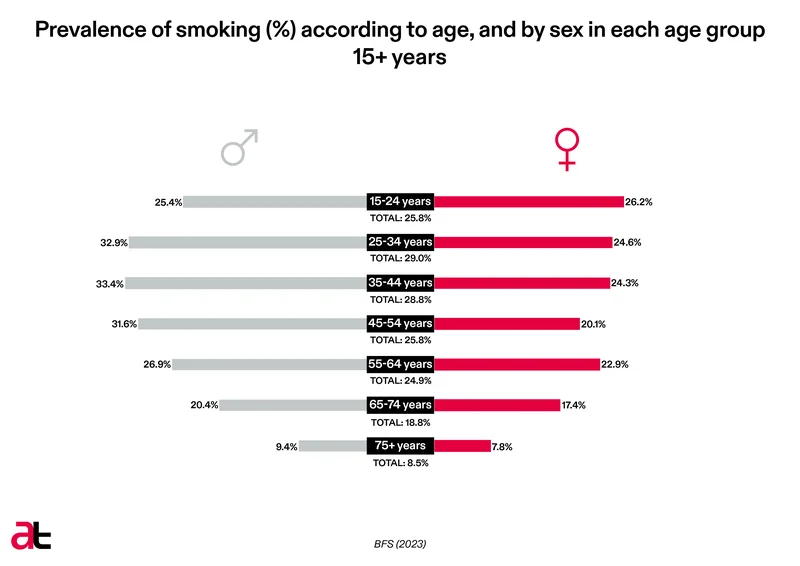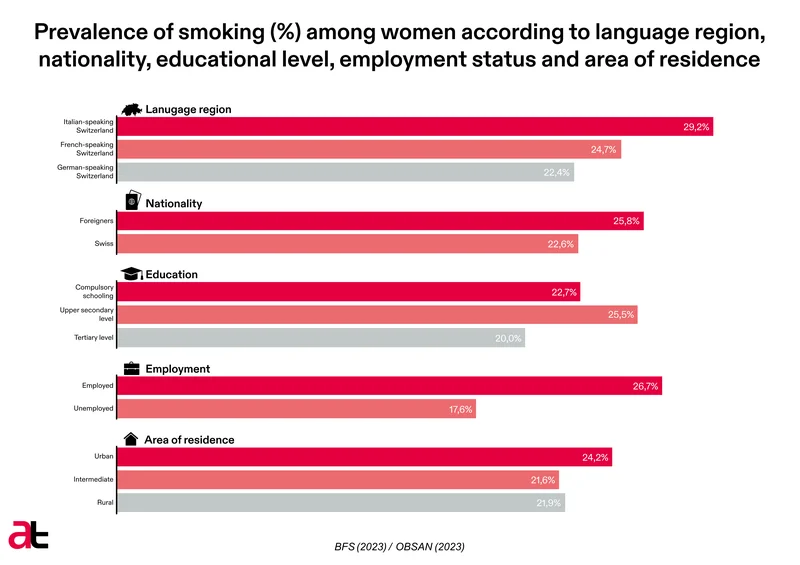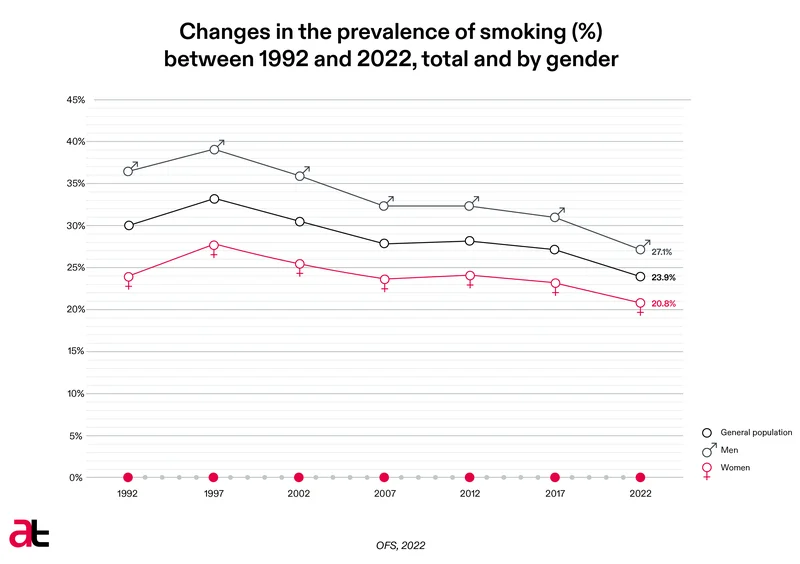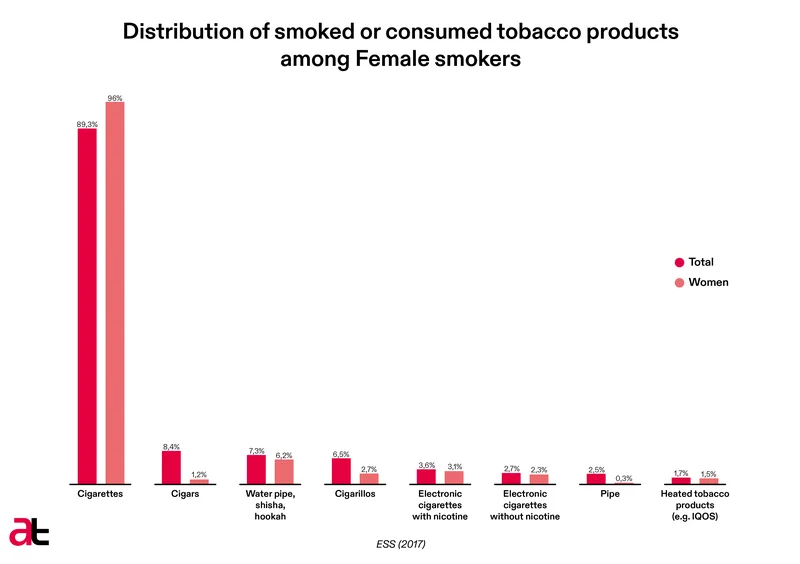Female smoking in Switzerland: an epidemiological perspective
More than one woman in five smokes
Linguistic, geographic and socioeconomic disparities
School surveys: One 15-year old schoolgirl in 30 smokes daily
Gender differences that have been diminishing for several decades
Young women are more often smokers than young men
Level of tobacco consumption by female smokers
Types of tobacco products consumed by women in Switzerland
School surveys: Types of products consumed by students
More than one in five women smokes
- In Switzerland, in 2022, more than one 15-year-old girl in five was a smoker (20.8%).
- Girls and women under age 45 are more affected by tobacco use than older women.
- At present, the prevalence of smoking among 15- to 25-year-old females (26.2%) is higher than that of males (25.4%).
Smoking concerns one-fifth of the female population, according to l’Enquête suisse sur la santé [Swiss health survey] (OFS, 2023[1]). The proportion of female smokers, however, varies significantly among different population subgroups, particularly according to age, but also according to other sociodemographic and economic characteristics.
In 2022, all ages combined, just over one in five females – 20.8% – age 15 or over was a smoker (for 27.1% of males; Figure W1). Tobacco use is not however distributed uniformly across the entire female population. The youngest groups are particularly affected. The prevalence of smoking is in effect highest among 15- to 24-year-old females: reaching 26.2% (among males, 35 to 44 year olds are the most strongly affected by tobacco use). Although slightly lower, the proportion was still 25% among 25- to 34-year-old females (24.6%) and females 35 to 44 years old (24.3%). In the “active” ages, the proportion of smokers was lowest among women ages 45 to 54 – one women in five (20.1%) still being a smoker in this age group. Note that the proportion of female smokers rose again in the 55 to 64 age group (22.9%).
A fact sufficiently rare that it should be highlighted: the 2022 ESS data suggest that currently, in the age group 15 to 24, the proportion of female smokers – 26.2% – surpasses that of male smokers – 25.4%. Such an observation is relatively exceptional from an epidemiological point of view.

Figure W1 – Prevalence of smoking (%) among women and men, in total and by age, ESS 2022 (OFS, 2023[2]).
Linguistic, geographic and socioeconomic disparities
Based on the 2022 Swiss Health Survey (ESS) data, variations are observed amongst the linguistic regions in the extent of female smoking (OBSAN, 2024[3]; Figure W2). Italian-speaking Switzerland (24.3% of female smokers) had a higher proportion of female smokers than French-speaking Switzerland (22.6%) and German-speaking Switzerland (19.9%). At the cantonal level, prevalence rates exceeding 25% were recorded only in the canton of Geneva. However, the proportion of female smokers exceeded the national share – as a reminder, 20.8% – in the following cantons: Ticino (24.6%), Basel-Stadt (24.5%), Thurgau (24.4%), Valais (22.5%), Vaud (22.0%) and Aargau (21.5%). In contrast, the cantons of St. Gallen, Nidwalden, Schwyz, Zurich, Lucerne, Basel-Landschaft and Grisons had female smoking prevalence rates below 20%. The canton of Zug recorded the lowest proportion of female smoking across all ages considered with a total of 14.5% of female smokers (OBSAN, 2024[4]). Still based on the 2022 ESS data, differences in relation to the types of residential regions were also observed: all linguistic regions and cantons combined, the prevalence of smoking was slightly higher amongst females living in so-called urban regions (21.5% of smokers) than amongst those living in rural (19.6%) or intermediate regions (19.6%; these differences did not, however, reach statistically significant levels).
The 2022 ESS data also reveal variations in smoking amongst females according to socioeconomic criteria such as nationality, whether or not they were engaged in paid employment and level of education (Figure W2). While the share of smokers reached 22.8% amongst women of other nationalities, it was 20.2% amongst Swiss women (a difference that is not statistically significant). Being considered active (working for pay) was even more strongly associated with a higher proportion of female smokers (23.0% versus 17.1% for non-active females; a statistically significant difference). Relatively significant differences were also observed amongst females over 25 years of age according to the level of education: those who had completed at most secondary II education (22.5%) and, to a lesser extent, those who had only completed compulsory education (19.8%) showed higher smoking rates than those who had completed higher vocational education or education in a university (17.2%).

Figure W2 – Prevalence of female smoking (%) according to linguistic region, nationality, educational level and work activity, ESS 2022 (OBSAN, 2024[5]).
School surveys: One in 30 15-year-old schoolgirl smokes daily
- Among 15-year-old girls, almost one in 30 smokes daily (3.1%) and approximately one girl in three (31.0%) has already tried smoking a cigarette.
Smoking figures from the Health Behaviour in School-aged Children (HBSC) survey (Delgrande et al., 2023[6]) reveal that in 2022, 3.1% of 11-year-old girls had already tried cigarettes (at least once in their life) and that this proportion increases considerably with age, reaching 31.0% by age 15. Cigarette consumption in the 30 days preceding the survey shows similar trends, with 16.6% of 15-year-old girls reporting having smoked in this time frame. Finally, although it remains almost non-existent below the age of 13, daily cigarette consumption already affected 0.5% of 13-year-old girls, 1.5% of 14-year-old girls and 3.1% of 15-year-old girls. Thus, in Switzerland in 2022, almost one in 30 15-year-old girls smoked daily.
Gender differences that have been diminishing for several decades
- During the 1990s, smoking among women increased significantly – even more than among men. It has since diminished, but less markedly among women than men.
- Gender differences have been continually diminishing for more than 30 years.
The Swiss Health Survey has been monitoring the evolution of tobacco consumption in the population age 15 and over since 1992. While an increase in smoking prevalence was observed among women over the period 1992 to1997 (+3.7 percentage points), this increase was followed by a phase of slight reductions between 1997 and 2007 (-2.3 percentage points in 2002; -1.9 percentage points in 2007). A phase of relative stagnation followed between 2007 and 2017 (+0.6 percentage points in 2012; -0.9 percentage points in 2017), before a new, more significant decline in 2022 (-2.5 percentage points; Figure W3). Although these trends are generally shared with the evolution of smoking prevalence among men, the ESS data highlight that the prevalence gap between men and women has continually narrowed since the early 1990s.
Note that a secondary analysis published in 2018 (Gmel et al., 2018[7]) jointly considered different sources of available data (the ESS, but also those of the Health Behavior in School-aged Children project and the Swiss Addiction Monitoring) and concluded in particular that, all ages combined, the evolution of tobacco consumption in Switzerland between 1992 and 2016 generally reflected what is described in international literature as the “smoking epidemic”[8],[9]. According to this concept, since smoking started and progressed more rapidly among men, peaks of higher prevalence are observed more quickly over time for men than for women. Similarly, after reaching a peak, the decrease in smoking prevalence would generally be anticipated over time for men, compared to women. According to this theory, women would follow in the footsteps of men 10 to 30 years later, both in the phase of progression of smoking and in the subsequent phases of stabilisation and reduction.

Figure W3 – Change in smoking prevalence (%) between 1992 and 2022, in total, by sex and by linguistic region, ESS 1992-2022 (OFS, 2023[10]).
Young women are more often smokers than young men
As mentioned previously, data from the 2022 ESS show that currently, in the age group 15 to 24, the proportion of female smokers – 26.2% – surpasses that of male smokers – 25.4%. And as also mentioned, such an observation is relatively exceptional from an epidemiological point of view. The finding is based on a difference in the evolution of smoking behaviours between males and females in this age group. While an overall trend towards a leveling out of gender differences has been observed since the implementation of the ESS (first survey in 1992), the 15- to 24-year-old age group appears to be particularly affected by this phenomenon.
In effect, the difference between males and females peaked at 10.3 percentage points for this age group during the first wave of the ESS (36.0% male smokers versus 25.7% female smokers in 1992). After a marked increase in smoking prevalence for both males (+10.6 percentage points) and females (+14.8 percentage points) in this age group in 1997, both population subgroups saw their smoking prevalence decrease more or less regularly until 2022, however not at the same rate: -10.6 percentage points for males ages 15 to 24 over the period 1992 – 2022 compared to +0.5 percentage points for females of this age group over this same period.
Note that since the 1997 peak in smoking prevalence, smoking has declined significantly more for males ages 15 to 24 than for men in age groups 25 to 34 and 35 to 44. This trend was not observed in females. Smoking among females ages 15 to 24 exceeds that of women ages 25 to 34 and 35 to 44. One plausible hypothesis is that preventative measures taken across Switzerland since the 1990s, which have mainly targeted the youngest population subgroups (i.e. minors and young adults), could have impacted young men differently to young women, possibly due to other external or environmental factors (e.g. in the marketing of tobacco products).
Tobacco consumption level of female smokers
- More than two-thirds of women smokers smoke daily, which represents around one woman in seven within the entire population (14.0%).
- Based on older data (2016), a woman who uses tobacco daily smokes an average of 11.3 cigarettes per day.
Regarding the intensity and level of consumption, the results of the Swiss Health Survey 2022 (ESS) currently available concern the proportion of people smoking daily and occasionally (OFS, 2024[11]), the proportion of people consuming on average a given number of cigarettes per day in the entire population (OFS, 2023[12]; OFS, 2024[13]) and the average number of cigarettes smoked per day, regardless of the frequency of consumption (OFS, 2024[14]). Overall, it is estimated that 14.0% of females ages 15 and older smoke daily and 6.8% of the female population smoke occasionally (OFS, 2024[15]). Thus, more than two-thirds of female smokers smoke daily. It should be noted that the age groups 55 to 64 years (17.7%) and 35 to 44 years (15.6%) are the most concerned by daily smoking. At the consumption level alone, the 2022 ESS data reveal that 2.3% of females consume on average one pack or more of cigarettes per day (compared to 6.1% of males; OFS, 2023[16]). The latest ESS data also inform us that female smokers – whether they smoke daily or not – consumed an average of seven cigarettes per day (compared to an average of nine for male smokers; OFS, 2024[17]). Secondary analyses produced for the Swiss Monitoring System for Addictions and Noncommunicable Diseases (MonAM), based on ESS data from 2017, reveal that just under one-sixth (15.1%) of female smokers consumed at least 20 cigarettes per day (OBSAN, 2024[18]). It should be noted that these data also highlight that the proportion of female smokers consuming at least 20 cigarettes is changing in stages amongst females: in 2017, this proportion was close to or less than 10% among female smokers under 35 and was close to or exceeded 20% amongst those in the 35 to 74 age groups.
It should also be noted that in 2016 the CoRolAR survey of the Swiss Monitoring of Addictions estimated that females who smoked cigarettes daily smoked an average of 11.3 cigarettes per day (compared to 15.4 cigarettes for a male daily smoker; Gmel et al., 2017[19]).
Types of tobacco products consumed by females in Switzerland
- The traditional cigarette is still by far the tobacco product most consumed by female smokers in Switzerland.
Regarding the types of tobacco products consumed, the most recent monitoring data detailed by gender as part of the 2022 Swiss Health Survey (ESS) report the use of tobacco products and e-cigarettes across the entire population, regardless of smoking status (OFS, 2024a[20]; OFS, 2024b[21]). They reveal that cigarettes are still the main smoking product amongst females in Switzerland: 18.6% of females consume tobacco in this form (amongst men this share is 22.0%). The use of other products appears more marginal, with 2.6% of females reporting consuming e-cigarettes (ENDS), 2.2% heated tobacco products such as IQOS, 1.1% smoking a water pipe (shisha or hookah), 0.5% consuming snus, 0.5% cigarillos, 0.2% cigars and finally less than 0.1% smoking a pipe (Figure A1A-9).
Concerning the female population’s use of the three flagship products – traditional cigarettes, e-cigarettes and heated tobacco products – while the highest prevalence of traditional cigarette use was recorded amongst females ages 15 to 24 (23.3%) and 25 to 34 (22.2%), the prevalence of e-cigarette use was clearly at its highest amongst 15- to 24-year-olds (5.6%; measurably higher than the 3.8% of 25- to 34-year-olds and the 3.4% of 35- to 44-year-olds). The prevalence of heated tobacco product use amongst females ages 35 to 44 was highest at 3.4%, compared to 3.1% amongst those ages 25 to 34 and 1.9% amongst those ages 15 to 24 (OFS,2024a[22]; OFS, 2024b[23]).
Additional data to that collected in the Swiss Health Survey (ESS) are available in the Federal Office of Public Health’s (OFSP) omnibus “Health and Lifestyle” survey[24]. These data detailing the prevalence of consumption of different tobacco products (or similar products) in the female population living in private households in Switzerland confirm the trends observed in the 2022 ESS: according to the 2023 data from this latter survey (OFSP, 2024[25]), 16.2% of females consume tobacco in the form of cigarettes (compared to 20.0% of males), 6.3% e-cigarettes (6.1% of males) and 3.3% heated tobacco products (3.0% of males).

Figure A1A-9 – Distribution of tobacco products consumed amongst the entire female population ages 15 and older (%), ESS 2022 (OFS, 2024a[26] et 2024b[27]).
School surveys: Types of products consumed by students
- In 2022, 5.6% of females ages 15 to 24 used e-cigarettes (ENDS; for 2.8% of the population ages 15 and older).
- At age 15, 7.5% of schoolgirls consume ENDS very frequently (at least 10 days over the course of the previous 30 days).
- A not insignificant proportion of 15-year-old girls also consume other tobacco products like water pipes (hookahs) and snus, as well as heated tobacco products (HTP).
The 2022 HBSC survey documented, in addition to questions concerning “traditional cigarettes”, the prevalence of electronic cigarette consumption (ENDS) for students ages 11 to 15, and for those ages 14 and 15 years, the prevalence of consumption of heated tobacco products (HTP), water pipes, snuff, and snus (Delgrande et al., 2023[28]).
As part of this survey, the prevalence of experience, or lifetime use, of electronic cigarettes among students reached 2.4% by the age of 11, 7.8% by age 12, 18.2% by age 13, 31.9 % by age 14, and 40.1% by age 15. The levels of prevalence were slightly lower for girls than for boys at each age.
The use of ENDS over the previous 30 days remained relatively limited among girls ages 11 (1.1%) and 12 (2.8%), but then increased rapidly: 10.0% of girls age 13, 19.1% of those age 14, and 25.0% of those age 15 reported ENDS use during the 30 days preceding their participation in the 2022 survey. Note that a considerable proportion of young girls ages 13 to 15 reported having used ENDS for 10 days or more in the 30 days preceding the survey: 3.4% – or more than one in 30 – at age 13; 5.9% – more than one in 17 – at age 14; and 7.4% – more than one in 14 – at age 15. Note that while in terms of prevalence of experience, boys systematically surpassed girls, girls systematically surpassed boys in terms of frequency of use – 10 days or more over the previous 30 days.
Concerning other tobacco products, the 2022 HBSC survey notes that 4.9% of 14-year-old girls and 8.0% of 15-year-old girls had smoked a water pipe at least once in the previous 30 days[29]. Also, 4.2% of 14-year-old girls and 5.6% of 15-year-old girls[30] had used snuff, and 2.4% of 14-year-old girls and 2.9% of 15-year-old girls had used tobacco products (HTP) during the 30 days preceding the survey[31].
[1] https://www.bfs.admin.ch/bfs/fr/home/statistiques/sante/enquetes/sgb.assetdetail.28725086.html; accessed 28.01.2024.
[2] https://www.bfs.admin.ch/bfs/fr/home/statistiques/sante/enquetes/sgb.assetdetail.28725086.html; accessed 28.01.2024.
[3] https://ind.obsan.admin.ch/fr/indicator/monam/consommation-de-tabac-age-15; accessed 19.11.2024.
[4] https://ind.obsan.admin.ch/fr/indicator/monam/consommation-de-tabac-age-15; accessed 19.11.2024.
[5] https://ind.obsan.admin.ch/fr/indicator/monam/consommation-de-tabac-age-15; accessed 19.11.2024.
[6] Delgrande Jordan, Marina ; Balsiger, Nora; Schmidhauser, Valentine. (2023). Consommation de substances psychoactives chez les 11 à 15 ans en Suisse - Situation en 2022 et évolution dans le temps - Résultats de l'étude Health Behaviour in School-aged Children (HBSC) (Rapport de recherche No 149). Lausanne: Addiction Suisse. Download.
[7] Gmel, Gerhard; Notari, Luca; Gmel, Christiane. (2018). Rauchen und Alkoholkonsum in der Schweiz: Trends über 25 Jahre, Kohorten Effekte und aktuelle Details in Ein-Jahres-Altersschritten – eine Analyse verschiedener Surveys. Sucht Schweiz. Lausanne. Download.
[8] Lopez, Alan D; Collishaw, Neil E; Piha Tapani. A descriptive model of the cigarette epidemic in developed countries. Tob Control. 1994;3:242–7.
[9] Thun, Michael; Peto, Richard; Boreham, Jillian; Lopez, Alan D. Stages of the cigarette epidemic on entering its second century. Tob Control. 2012;21:96–101.
[10] https://www.bfs.admin.ch/bfs/fr/home/statistiques/sante/enquetes/sgb.assetdetail.28725086.html; accessed 12.01.2024.
[11] https://www.bfs.admin.ch/bfs/fr/home.assetdetail.30305684.html; accessed 02.02.2024.
[12] https://www.bfs.admin.ch/bfs/fr/home/statistiques/sante/enquetes/sgb.assetdetail.28845217.html; accessed 28.01.2024.
[13] OFS (2024). OFS News – Swiss Health Study (ESS) – Tobacco Consumption from 1992 to 2022. OFS. Neuchâtel. Download.
[14] OFS (2024). OFS News – Swiss Health Study (ESS) – Tobacco Consumption from 1992 to 2022. OFS. Neuchâtel. Download.
[15] https://www.bfs.admin.ch/bfs/fr/home.assetdetail.30305684.html; accessed 02.02.2024.
[16] https://www.bfs.admin.ch/bfs/fr/home/statistiques/sante/enquetes/sgb.assetdetail.28845217.html; accessed 28.01.2024.
[17] OFS (2024). OFS News – Swiss Health Survey – Tobacco Consumption from 1992 to 2022. OFS. Neuchâtel. Download.
[18] https://ind.obsan.admin.ch/fr/indicator/monam/tabac-nombre-de-cigarettes-fumees-par-jour-age-15; accessed 28.01.2024.
[19] Gmel, Gerhard; Kuendig, Hervé; Notari, Luca. (2017). Monitorage suisse des addictions Consommation d’alcool, de tabac et de drogues illégales en Suisse en 2016. Sucht Schweiz. Lausanne. Download.
[20] OFS (2024a). Standard tables: Consumption of tobacco products and e-cigarettes (1 de 2). OFS. Neuchâtel. Download.
[21] OFS (2024b). Standard tables: Consumption of tobacco products and e-cigarettes (2 de 2). OFS. Neuchâtel. Download.
[22] OFS (2024a). Standard tables: Consumption of tobacco products and e-cigarettes (1 de 2). OFS. Neuchâtel. Download.
[23] OFS (2024b). Standard tables: Consumption of tobacco products and e-cigarettes (2 de 2). OFS. Neuchâtel. Download.
[24] www.bag.admin.ch/en/health-and-lifestyle-survey; accessed 08.12.2025.
[25] www.bag.admin.ch/dam/en/sd-web/TlblOEe64Tff/sante-lifestyle-2023-praevalenz-tabak-nikotin.xlsx; accessed 08.12.2025.
[26] OFS (2024a). Standard tables: Consumption of tobacco products and e-cigarettes (1 de 2). OFS. Neuchâtel. Download.
[27] OFS (2024b). Standard tables: Consumption of tobacco products and e-cigarettes (2 de 2). OFS. Neuchâtel. Download.
[28] Delgrande Jordan, Marina; Balsiger, Nora; Schmidhauser, Valentine. (2023). Consommation de substances psychoactives chez les 11 à 15 ans en Suisse - Situation en 2022 et évolution dans le temps - Résultats de l'étude Health Behaviour in School-aged Children (HBSC) (Rapport de recherche No 149). Lausanne: Addiction Suisse. Download.
[29] https://www.hbsc.ch/fr/tableaux-standards/substance_use/thirty-day-prevalence-waterpipe.html; accessed 28.01.2024.
[30] https://www.hbsc.ch/fr/tableaux-standards/substance_use/thrity-day-prevalence-snus.html; accessed 28.01.2024.
[31] https://www.hbsc.ch/fr/tableaux-standards/substance_use/thirty-day-prevalence-heat-not-burn.html; accessed 28.01.2024.
AT Switzerland, February 2025